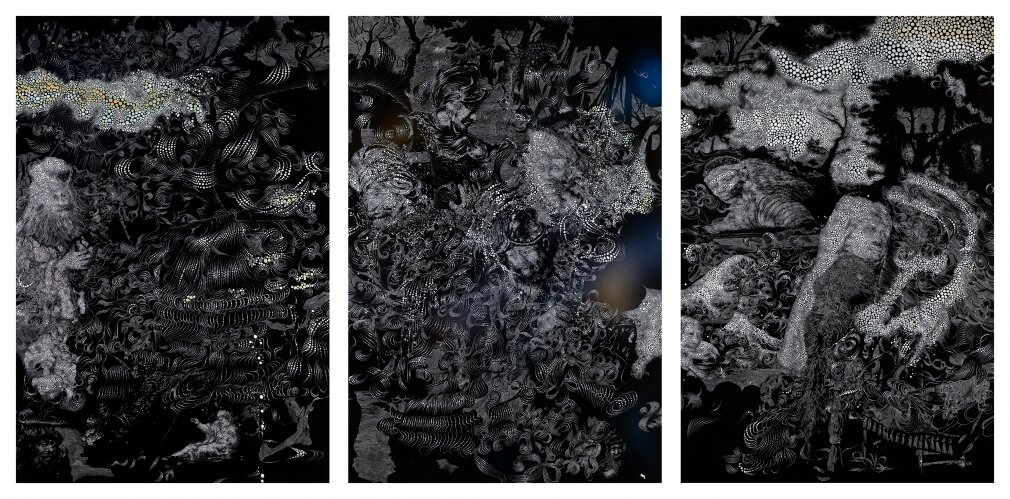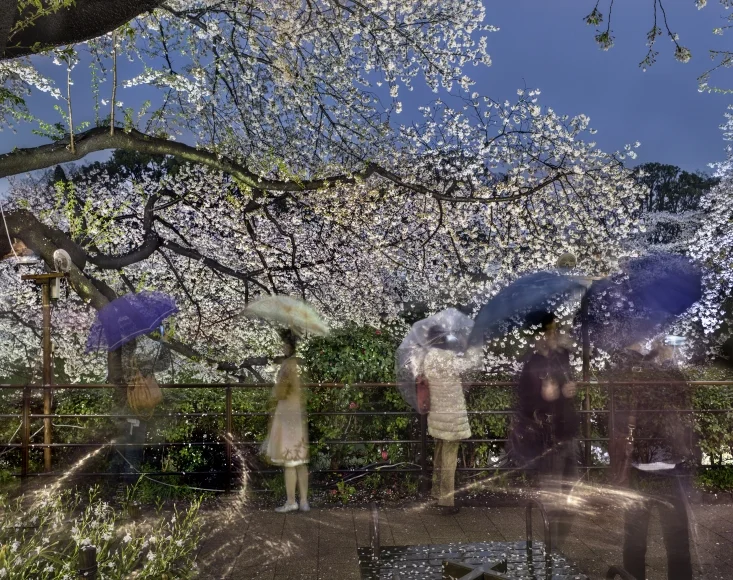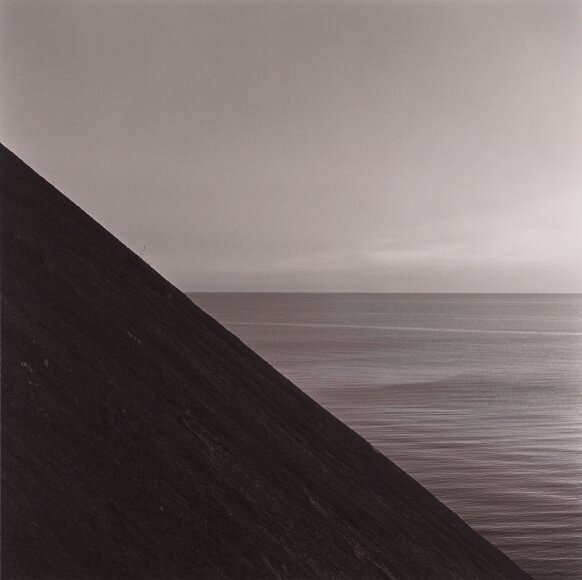
Picture Stories: Photographs by Arlene Gottfried | The New York Historical
The New York Historical
31. Januar – 25. Mai 2025
Picture Stories: Photographs by Arlene Gottfried
Eternal Light Choir Performing, 1980 Cibachrome print The New York Historical, Gift of Sally Klingenstein Martell © Estate of Arlene Gottfried
Das New York Historical freut sich, die Eröffnung von „Picture Stories: Photographs by Arlene Gottfried“ ankündigen zu können, einer Ausstellung, die das lebendige, raue und zutiefst menschliche New York City erforscht, das von der Fotografin Arlene Gottfried (1950–2017) eingefangen wurde. Die Ausstellung, die am 31. Januar 2025 eröffnet wird, zeigt mehr als 30 Fotografien aus dem jüngsten Erwerb von Gottfrieds Werken durch das Museum und bietet einen seltenen Einblick in das Leben und den Geist der New Yorker im späten 20. Jahrhundert.
"Meine Mutter pflegte zu sagen: ‚Arlene – lauf nur nicht herum!‘ Dann begann ich zu wandern, aber ich besorgte mir eine Kamera, weil sie dem Ganzen etwas mehr Bedeutung verlieh ... ein Leben des Wanderns ist wirklich das, worum es geht“, sagte Gottfried einmal. Mit ihrer Kamera in der Hand durchstreifte sie jeden Winkel der Stadt und hielt eine Reihe von Motiven fest, von Harlems Gospelsängern über die Underground-Szenen der Lower East Side bis hin zu den pulsierenden Nachtclubs von Midtown und den sonnenverwöhnten Menschenmassen auf Coney Island. Diese Ausstellung bringt Gottfrieds sensible, ehrliche und manchmal schonungslose Darstellung der vielfältigen Bevölkerung New Yorks die längst überfällige Anerkennung.
„Arlene Gottfrieds Fotografien fangen intime Ausschnitte der Menschen und Orte New Yorks ein und bieten den Betrachtern eine herzliche und ehrliche Darstellung der Stadt, wie sie nur ein echter New Yorker vermitteln kann“, sagte Dr. Louise Mirrer, Präsidentin und CEO von The New York Historical. „Wir sind unserer Treuhänderin Sally Klingenstein Martell sehr dankbar, dass sie uns beim Erwerb dieser Fotografien unterstützt hat, und Dara Gottfried dafür, dass sie The New York Historical ausgewählt hat, um Arlenes Vermächtnis fortzusetzen.“
Diese Ausstellung feiert den jüngsten Erwerb von fast 300 Werken Gottfrieds, die aus ihrem Nachlass stammen und durch die großzügige Unterstützung von Sally Klingenstein Martell, Kuratorin von The New York Historical, erworben wurden. Die Ausstellung wurde von Marilyn S. Kushner, Kuratorin für Drucke, Fotografien und Architekturzeichnungen, kuratiert und wirft ein Licht auf Gottfrieds unterrepräsentiertes künstlerisches Schaffen, indem sie ihr Werk als tiefgründige Dokumentation der facettenreichen Menschlichkeit der Stadt offenbart.
„Arlene hatte die außergewöhnliche Fähigkeit, Menschen hinter der Oberfläche zu sehen und ihre Freuden, Nöte und ihre Widerstandsfähigkeit einzufangen“, sagte Kushner. “Mit ihren Fotografien lädt sie uns ein, uns mit einem New York auseinanderzusetzen, das intim, herausfordernd und wunderbar vielfältig war. Diese Ausstellung ist eine Hommage an ihre einzigartige Vision und ihr bemerkenswertes Einfühlungsvermögen für ihre Motive.“
„Ich freue mich sehr, dass das New York Historical Museum diese außergewöhnliche Sammlung erworben hat“, sagte Sally Klingenstein Martell, Kuratorin des New York Historical Museum. “Arlene Gottfrieds Werk hat einen immensen künstlerischen Wert und dient gleichzeitig als ergreifende Dokumentation einer Stadt, die langsam in Vergessenheit gerät. Ich habe keinen Zweifel daran, dass das New York Historical Museum aus Arlenes Archiven schöpfen wird, um seine Ausstellungen in den kommenden Jahren zu bereichern.“
„Als Arlenes Schwägerin hatte ich das Privileg, ihre bemerkenswerte Leidenschaft dafür zu erleben, wie sie die Schönheit und Menschlichkeit des Alltags durch ihre Straßenfotografie einfing“, sagte Dara Gottfried. “Vor ihrem Tod vertraute sie mir die Verantwortung an, ihr riesiges Archiv zu verwalten und ihre Arbeit mit der Welt zu teilen. Es gibt keine bessere Möglichkeit, ihren Wünschen gerecht zu werden, als ihre Kunst im New York Historical auszustellen und sie für immer in seiner Bibliothek zu bewahren, wo sie auch zukünftige Generationen inspirieren und berühren kann.“
Ausstellungen im New York Historical werden ermöglicht durch Dr. Agnes Hsu-Tang und Oscar Tang, den Saunders Trust for American History, den Evelyn & Seymour Neuman Fund, das New York City Department of Cultural Affairs in Zusammenarbeit mit dem Stadtrat und den New York State Council on the Arts mit Unterstützung des Office of the Governor und der New York State Legislature. WNET ist der Mediensponsor.
Ann Magnuson on Stairwell, 1984 Gelatin silver print The New York Historical, Gift of Sally Klingenstein Martell © Estate of Arlene Gottfried
Le New York Historical est heureux d'annoncer l'ouverture de Picture Stories : Photographs by Arlene Gottfried, une exposition qui explore la ville de New York vibrante, grinçante et profondément humaine capturée par la photographe Arlene Gottfried (1950-2017). Inaugurée le 31 janvier 2025, cette exposition présente plus de 30 photographies issues de la récente acquisition d'œuvres de Gottfried par le musée, offrant un rare aperçu de la vie et de l'esprit des New-Yorkais de la fin du XXe siècle.
Ma mère avait l'habitude de dire : « Arlene, ne t'éloigne pas ! Alors j'ai commencé à errer, mais j'ai pris un appareil photo parce que cela donnait un peu plus de sens... une vie d'errance, c'est vraiment ce que c'est », a déclaré un jour Mme Gottfried. Son appareil photo à la main, elle a parcouru tous les coins de la ville, capturant un éventail de sujets allant des chanteurs de gospel de Harlem aux scènes underground du Lower East Side, en passant par les boîtes de nuit animées de Midtown et les foules gorgées de soleil de Coney Island. Cette exposition apporte une reconnaissance qui n'a que trop tardé à la sensibilité, à l'honnêteté et parfois à l'acuité des portraits de la population diversifiée de New York réalisés par Arlene Gottfried.
« Les photographies d'Arlene Gottfried capturent des tranches intimes de la population et des lieux de New York, offrant aux spectateurs un portrait sincère et honnête de la ville que seule une vraie New-Yorkaise peut transmettre », a déclaré Louise Mirrer, présidente-directrice générale de l'Institut historique de New York. « Nous sommes incroyablement reconnaissants à notre administratrice, Sally Klingenstein Martell, de nous avoir aidés à acquérir ces photographies, et à Dara Gottfried d'avoir choisi The New York Historical pour perpétuer l'héritage d'Arlene ».
Cette exposition célèbre l'acquisition récente de près de 300 œuvres de Gottfried, données par sa succession et acquises grâce au soutien généreux de Sally Klingenstein Martell, administratrice de The New York Historical. Organisée par Marilyn S. Kushner, conservatrice des estampes, des photographies et des dessins d'architecture, l'exposition met en lumière l'art sous-représenté de Gottfried, révélant que son travail est une documentation profonde de l'humanité à multiples facettes de la ville.
« Arlene avait une capacité extraordinaire à voir les gens au-delà de la surface, à capturer leurs joies, leurs difficultés et leur résilience », a déclaré M. Kushner. « À travers ses photographies, elle nous invite à nous engager dans un New York intime, stimulant et merveilleusement diversifié. Cette exposition est un hommage à sa vision unique et à sa remarquable empathie pour ses sujets ».
« Je suis ravie que The New York Historical ait acquis cette extraordinaire collection », a déclaré Sally Klingenstein Martell, administratrice de The New York Historical. « L'œuvre d'Arlene Gottfried possède une immense valeur artistique tout en constituant un témoignage poignant d'une ville qui est en train de sombrer dans la mémoire. Je ne doute pas que The New York Historical puisera dans les archives d'Arlene pour enrichir ses expositions dans les années à venir ».
« En tant que belle-sœur d'Arlene, j'ai eu le privilège d'être témoin de sa remarquable passion pour la capture de la beauté et de l'humanité de la vie quotidienne à travers ses photographies de rue », a déclaré Dara Gottfried. « Avant son décès, elle m'a confié la responsabilité de gérer ses vastes archives et de partager son travail avec le monde entier. Il n'y a pas de meilleure façon d'honorer ses souhaits que de voir son art exposé au New York Historical et préservé à jamais dans sa bibliothèque, où il pourra continuer à inspirer et à résonner auprès des générations futures. »
Les expositions au New York Historical sont rendues possibles par le Dr Agnes Hsu-Tang et Oscar Tang, le Saunders Trust for American History, le Evelyn & Seymour Neuman Fund, le département des affaires culturelles de la ville de New York en partenariat avec le conseil municipal, et le New York State Council on the Arts avec le soutien du bureau du gouverneur et de la législature de l'État de New York. WNET est le sponsor média.
Mommie Kissing Bubbie Delancey St, 1979, Gelatin silver print The New York Historical, Gift of Dara and Karen Gottfried in memory of Arlene Gottfried © Estate of Arlene Gottfried
Il New York Historical è lieto di annunciare l'apertura di Picture Stories: Photographs by Arlene Gottfried, una mostra che esplora la New York vibrante, grintosa e profondamente umana catturata dalla fotografa Arlene Gottfried (1950-2017). La mostra, che aprirà il 31 gennaio 2025, presenta più di 30 fotografie tratte dalla recente acquisizione di opere della Gottfried da parte del Museo, offrendo un raro sguardo sulla vita e sullo spirito dei newyorkesi della fine del XX secolo.
Mia madre mi diceva sempre: “Arlene, non vagare!”. Poi ho iniziato a vagare, ma ho preso una macchina fotografica perché mi ha dato un po' più di significato... una vita di vagabondaggio è davvero quello che è”, ha detto una volta la Gottfried. Con la sua macchina fotografica in mano, ha girato ogni angolo della città, immortalando una serie di soggetti, dai cantanti gospel di Harlem alle scene underground del Lower East Side, dai vibranti locali notturni di Midtown alle folle assolate di Coney Island. Questa mostra porta il riconoscimento, da tempo atteso, del ritratto sensibile, onesto e a volte crudo della variegata popolazione di New York che Gottfried ha realizzato.
“Le fotografie di Arlene Gottfried catturano fette intime della gente e dei luoghi di New York, offrendo agli spettatori un ritratto sincero e onesto della città che solo un vero newyorkese potrebbe trasmettere”, ha dichiarato la dott.ssa Louise Mirrer, presidente e CEO del New York Historical. “Siamo incredibilmente grati alla nostra fiduciaria, Sally Klingenstein Martell, per averci aiutato ad acquisire queste fotografie, e a Dara Gottfried per aver scelto il New York Historical per continuare l'eredità di Arlene”.
Questa mostra celebra la recente acquisizione di quasi 300 opere della Gottfried, donate dal suo patrimonio e acquisite grazie al generoso sostegno di Sally Klingenstein Martell, fiduciaria del New York Historical. Curata da Marilyn S. Kushner, curatrice di stampe, fotografie e disegni architettonici, la mostra mette in luce l'arte poco rappresentata della Gottfried, rivelando il suo lavoro come una profonda documentazione della multiforme umanità della città.
“Arlene aveva una straordinaria capacità di vedere le persone al di là della superficie, catturando le loro gioie, le loro difficoltà e la loro capacità di recupero”, ha dichiarato Kushner. “Attraverso le sue fotografie, ci invita a confrontarci con una New York intima, stimolante e meravigliosamente diversa. Questa mostra è un tributo alla sua visione unica e alla sua notevole empatia per i suoi soggetti”.
“Sono lieta che il New York Historical abbia acquisito questa straordinaria collezione”, ha dichiarato Sally Klingenstein Martell, fiduciaria del New York Historical. “Il lavoro di Arlene Gottfried ha un immenso valore artistico e allo stesso tempo rappresenta una testimonianza toccante di una città che sta scivolando nella memoria. Non ho dubbi che il New York Historical attingerà agli archivi di Arlene per arricchire le sue mostre negli anni a venire”.
“Come cognata di Arlene, ho avuto il privilegio di assistere alla sua straordinaria passione nel catturare la bellezza e l'umanità della vita quotidiana attraverso la fotografia di strada”, ha dichiarato Dara Gottfried. “Prima di morire, mi ha affidato la responsabilità di gestire il suo vasto archivio e di condividere il suo lavoro con il mondo. Non c'è modo migliore per onorare i suoi desideri che vedere la sua arte esposta al New York Historical e conservata per sempre nella sua biblioteca, dove potrà continuare a ispirare e risuonare con le generazioni future”.
Le mostre al New York Historical sono rese possibili dai dottori Agnes Hsu-Tang e Oscar Tang, dal Saunders Trust for American History, dall'Evelyn & Seymour Neuman Fund, dal Dipartimento degli Affari Culturali della città di New York in collaborazione con il Comune e dal New York State Council on the Arts con il sostegno dell'Ufficio del Governatore e della Legislatura dello Stato di New York. WNET è lo sponsor mediatico.
Men’s Room at Disco, 1978, Gelatin silver print, The New York Historical, Gift of Dara and Karen Gottfried in memory of Arlene Gottfried © Estate of Arlene Gottfried
The New York Historical is excited to announce the opening of Picture Stories: Photographs by Arlene Gottfried, an exhibition that explores the vibrant, gritty, and deeply human New York City captured by photographer Arlene Gottfried (1950–2017). Opening January 31, 2025, this exhibition features more than 30 photographs from the Museum’s recent acquisition of Gottfried’s works, offering a rare glimpse into the life and spirit of New Yorkers from the late 20th century.
“My mother used to say ‘Arlene—just don’t wander!’ Then I started wandering, but I got a camera because it gave it a little more meaning...a life of wandering is really what it all is,” Gottfried once said. With her camera in hand, she roamed every corner of the city, capturing a range of subjects from Harlem’s gospel singers to the Lower East Side’s underground scenes, the vibrant nightclubs of Midtown, and the sun-soaked crowds on Coney Island. This exhibition brings long-overdue recognition to Gottfried’s sensitive, honest, and sometimes searing portrayal of New York’s diverse population.
“Arlene Gottfried’s photographs capture intimate slices of New York’s people and places, offering viewers a heartfelt and honest portrayal of the city that only a true New Yorker could convey,” said Dr. Louise Mirrer, president and CEO, The New York Historical. “We’re incredibly grateful to our trustee, Sally Klingenstein Martell, for helping us acquire these photographs, and to Dara Gottfried for choosing The New York Historical to continue Arlene’s legacy.”
This exhibition celebrates the recent acquisition of nearly 300 of Gottfried’s works, gifted by her estate and acquired through the generous support of Sally Klingenstein Martell, trustee of The New York Historical. Curated by Marilyn S. Kushner, curator of prints, photographs, and architectural drawings, the exhibition shines a light on Gottfried’s underrepresented artistry, revealing her work as a profound documentation of the city’s multifaceted humanity.
“Arlene had an extraordinary ability to see people beyond the surface, capturing their joys, hardships, and resilience,” said Kushner. “Through her photographs, she invites us to engage with a New York that was intimate, challenging, and wonderfully diverse. This exhibition is a tribute to her unique vision and her remarkable empathy for her subjects.”
“I’m delighted that The New York Historical has acquired this extraordinary collection,” said Sally Klingenstein Martell, trustee of The New York Historical. “Arlene Gottfried's work holds immense artistic value while also serving as a poignant record of a city that is slipping into memory. I have no doubt The New York Historical will draw from Arlene’s archives to enrich its exhibitions for years to come.”
“As Arlene’s sister-in-law, I had the privilege of witnessing her remarkable passion for capturing the beauty and humanity of everyday life through her street photography,” said Dara Gottfried. “Before she passed, she entrusted me with the responsibility of managing her vast archive and sharing her work with the world. There is no greater way to honor her wishes than to see her art exhibited at The New York Historical and preserved forever in its library, where it can continue to inspire and resonate with future generations.”
Exhibitions at The New York Historical are made possible by Dr. Agnes Hsu-Tang and Oscar Tang, the Saunders Trust for American History, the Evelyn & Seymour Neuman Fund, the New York City Department of Cultural Affairs in partnership with the City Council, and the New York State Council on the Arts with the support of the Office of the Governor and the New York State Legislature. WNET is the media sponsor.
(Text: The New York Historical)














